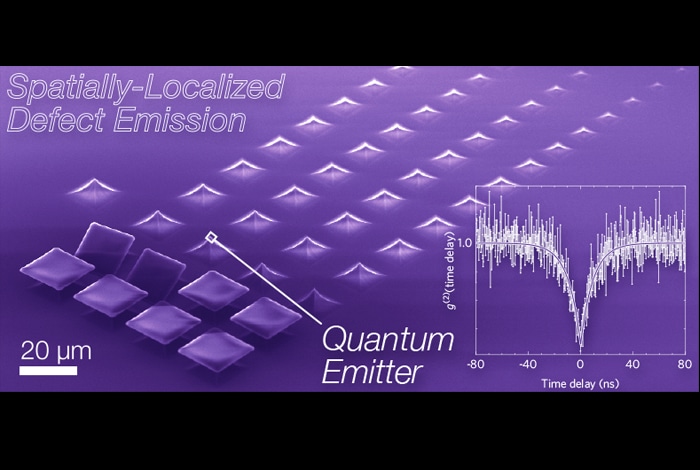May 30 2019
A new study has revealed a novel technique for developing thin films to regulate the emission of single photons. The study has boosted the efforts to develop reliable light-based quantum computing, quantum key distribution for cybersecurity, and other technologies.
 An innovative method for controlling single-photon emission for specific locations in 2D materials may offer a new path toward all-optical quantum computers and other quantum technologies. This image shows a false-color scanning electron micrograph of the array used to create place single-photon sources in epitaxial tungsten diselenide. Inset shows the Hanbury-Brown Twiss interferometry measurement proving quantum emission. (Image credit: Michael Pettes, Los Alamos National Laboratory)
An innovative method for controlling single-photon emission for specific locations in 2D materials may offer a new path toward all-optical quantum computers and other quantum technologies. This image shows a false-color scanning electron micrograph of the array used to create place single-photon sources in epitaxial tungsten diselenide. Inset shows the Hanbury-Brown Twiss interferometry measurement proving quantum emission. (Image credit: Michael Pettes, Los Alamos National Laboratory)
Efficiently controlling certain thin-film materials so they emit single photons at precise locations—what’s known as deterministic quantum emission—paves the way for beyond-lab-scale quantum materials.
Michael Pettes, Materials Scientist, Los Alamos National Laboratory
Pettes is the leader of the multi-institution research group.
Thanks to the scalability of these two-dimensional, selenium/tungsten thin films, they are potentially useful in processes for producing quantum technologies. All-optical quantum computing and key distribution in quantum communications necessitate single-photon generation, and it is vital for achieving further progress in quantum information technologies.
The study, published as a Featured Article in the Applied Physics Letters journal this week, makes use of strain at highly spatially localized and well-separated emission sites, or tips, in a selenium/tungsten film. The researchers created the film by means of chemical vapor deposition by making use of a multi-step, diffusion-mediated gas source.
The material is extremely thin, thus it conforms to the radius of the tips and bends toward the substrate by over a few percent, similar to a person lying on a bed of nails. The ensuing strain is sufficient to modify the electronic structure, but just at the tips. The affected area emits light of a different nature and color compared to light from the rest of the film.
While more research is needed to fully understand the role of mechanical deformation in creating these quantum emission sites, we may enable a route to control quantum optical properties by using strain. These single-photon sources form the basis for photonics-based, all-optical quantum computing schemes.
Michael Pettes, Materials Scientist, Los Alamos National Laboratory
According to the authors, quantum emission engineering in 2D materials is still in its initial phase. Although studies have detected the origin of single photons from defect structures in these materials, earlier work has proposed that the effect may be regulated by non-uniform strain fields. However, the mechanism behind this emergent phenomenon stays obscure and is the focus of study underway at Los Alamos.
The study at Los Alamos National Laboratory was supported by the Laboratory Directed Research and Development Program (LDRD 20190516ECR) and the Center for Integrated Nanotechnologies (CINT), a DOE nanoscience research center jointly operated by Los Alamos and Sandia national laboratories. Upgrades to the tandem accelerator were supported by the Principal Associate Directorate for Science, Technology, and Engineering capital investment fund, and the CINT capability development fund.